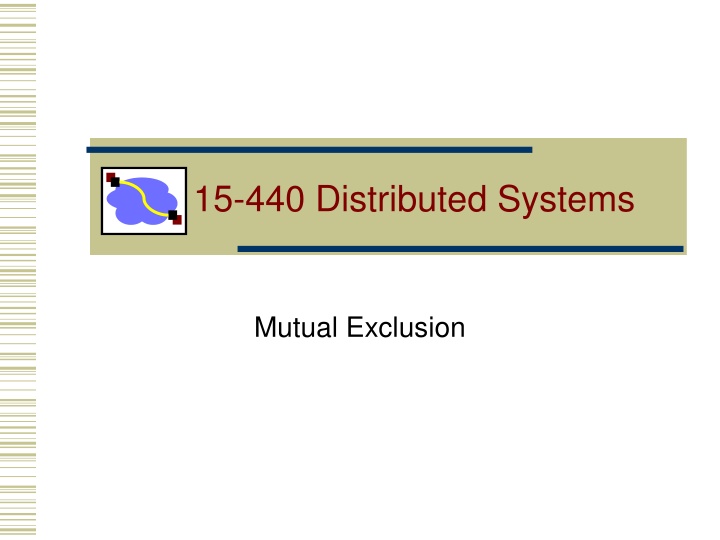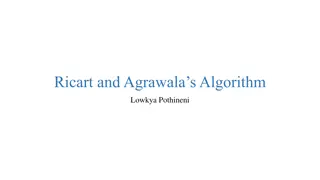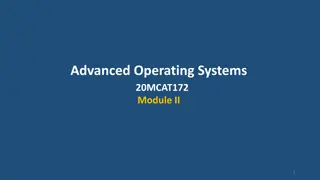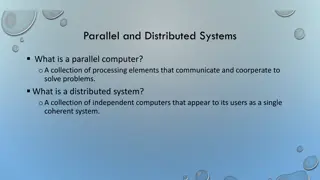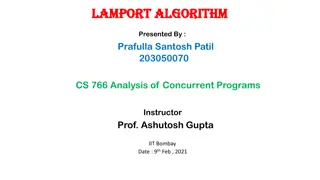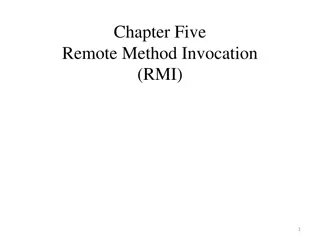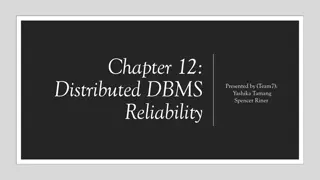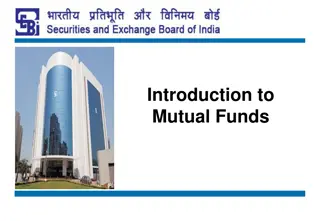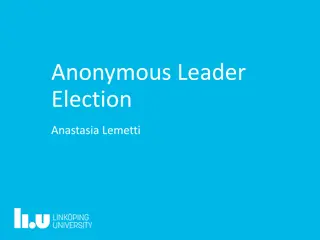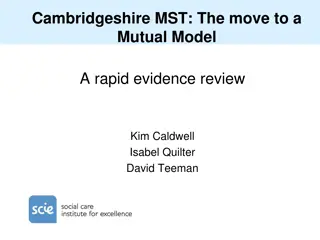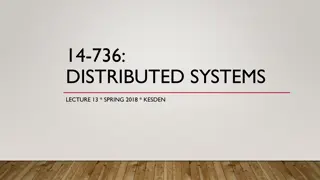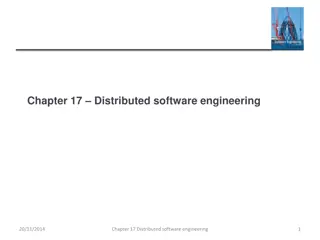Distributed Systems Mutual Exclusion
This collection discusses mutual exclusion in distributed systems, covering algorithms, requirements, fairness, safety, and more. Explore centralized and distributed mutual exclusion scenarios with detailed examples and images.
Download Presentation

Please find below an Image/Link to download the presentation.
The content on the website is provided AS IS for your information and personal use only. It may not be sold, licensed, or shared on other websites without obtaining consent from the author.If you encounter any issues during the download, it is possible that the publisher has removed the file from their server.
You are allowed to download the files provided on this website for personal or commercial use, subject to the condition that they are used lawfully. All files are the property of their respective owners.
The content on the website is provided AS IS for your information and personal use only. It may not be sold, licensed, or shared on other websites without obtaining consent from the author.
E N D
Presentation Transcript
15-440 Distributed Systems Mutual Exclusion
HW1 due and P1 update P1 due date error Checkpoint: 10/04 Part A: 10/13 Part B: 10/25 Note that there are 3 separate due dates! 2
Distributed Database (+$100) (+1%) (San Francisco) (New York) San Fran customer adds $100, NY bank adds 1% interest San Fran will have $1,111 and NY will have $1,110 Updating a replicated database and leaving it in an inconsistent state. 3
Today's Lecture Centralized Mutual Exclusion Totally Ordered Multicast Distributed Mutual Exclusion 4
Mutual Exclusion while true: Perform local operations Acquire(lock) Execute critical section Release(lock) Must ensure that only one instance of code is in critical section Whereas multithreaded systems can use shared memory, we assume that processes can only coordinate via message passing. 5
Requirements 1. Correctness/Safety: At most one process holds the lock/enter C.S. at a time 2. Fairness: Any process that makes a request must be granted lock Implies that system must be deadlock-free Assumes that no process will hold onto a lock indefinitely Eventual fairness: Waiting process will not be excluded forever Bounded fairness: Waiting process will get lock within some bounded number of cycles (typically n) 6
Other Requirements 1. Low message overhead 2. No bottlenecks 3. Tolerate out-of-order messages 4. Allow processes to join protocol or to drop out 5. Tolerate failed processes 6. Tolerate dropped messages Today, will focus on 1-3 Total number of processes is fixed at n No process fails or misbehaves Communication never fails, but messages may be delivered out of order. 7
Mutual Exclusion A Centralized Algorithm (1) @ Server: while true: m = Receive() If m == (Request, i): If Available(): Send (Grant) to i @ Client Acquire: Send (Request, i) to coordinator Wait for reply 8
Mutual Exclusion A Centralized Algorithm (2) @ Server: while true: m = Receive() If m == (Request, i): If Available(): Send (Grant) to I else: Add i to Q 9
Mutual Exclusion A Centralized Algorithm (3) @ Server: while true: m = Receive() If m == (Request, i): If Available(): Send (Grant) to I else: Add i to Q If m == (Release)&&!empty(Q): Remove ID j from Q Send (Grant) to j @ Client Release: Send (Release) to coordinator 10
Mutual Exclusion A Centralized Algorithm (4) Correctness: Clearly safe Fairness depends on queuing policy. E.g., if always gave priority to lowest process ID, then processes 1 & 2 lock out 3 Performance "cycle" is a complete round of the protocol with one process i entering its critical section and then exiting. 3 messages per cycle (1 request, 1 grant, 1 release) Lock server creates bottleneck Issues What happens when coordinator crashes? What happens when it reboots? 11
Selecting a Leader (Elections) P notices that leader has failed The Bully Algorithm 1. P sends an ELECTION message to all processes with higher numbers. 2. If no one responds, P wins the election and becomes coordinator. 3. If one of the higher-ups answers, it takes over. P s job is done. 12
The Bully Algorithm The bully election algorithm. (a) Process 4 holds an election. (b) Processes 5 and 6 respond, telling 4 to stop. (c) Now 5 and 6 each hold an election. 13
The Bully Algorithm The bully election algorithm. (d) Process 6 tells 5 to stop. (e) Process 6 wins and tells everyone. 14
Today's Lecture Centralized Mutual Exclusion Totally Ordered Multicast Distributed Mutual Exclusion 16
Decentralized Algorithm Strawman Assume that there are n coordinators Access requires a majority vote from m > n/2 coordinators. A coordinator always responds immediately to a request with GRANT or DENY Node failures are still a problem Coordinators may forget vote on reboot What if you get less than m votes? Backoff and retry later Large numbers of nodes requesting access can affect availability Starvation! 17
Example: Totally-Ordered Multicasting (+$100) (+1%) (San Francisco) (New York) San Fran customer adds $100, NY bank adds 1% interest San Fran will have $1,111 and NY will have $1,110 Updating a replicated database and leaving it in an inconsistent state. Can use Lamport s to totally order 18
Lamport Clock (1) 1 2 p1 a b m1 3 4 Physical time p2 c d m2 5 1 p3 e f Rule 1: Li is incremented by 1 before each event at process pi Rule 2: (a) when process pi sends message m, it piggybacks t = Li (b) when pj receives (m,t) it sets Lj := max(Lj, t) and applies rule 1 before timestamping the event receive (m) Use Lamport s algorithm, but break ties using the process ID L(e) = M * Li(e) + i M = maximum number of processes i = process ID 19
Example: Totally-Ordered Multicasting (+$100) (+1%) (San Francisco) (New York) Can use Lamport s to totally order But would need to be able to roll back events Maybe a large number of them! Could we make sure things are in the right order before processing? 20
Totally-Ordered Multicast A multicast operation by which all messages are delivered in the same order to each receiver. Lamport Details: Each message is timestamped with the current logical time of its sender. Multicast messages are also sent back to the sender. Assume all messages sent by one sender are received in the order they were sent and that no messages are lost. 21
Totally-Ordered Multicast Lamport Details (cont): Receiving process puts a message into a local queue ordered according to timestamp. The receiver multicasts an ACK to all other processes. Only deliver message when it is *both* at the head of queue and ack ed by all participants 22
Example: Totally-Ordered Multicasting (+$100) (+1%) (San Francisco) (New York) What are the timestamps of the updates and ACKs? 23
Totally-Ordered Multicast Lamport Details (cont): Receiving process puts a message into a local queue ordered according to timestamp. The receiver multicasts an ACK to all other processes. Only deliver message when it is *both* at the head of queue and ack ed by all participants Why does this work? Key point from Lamport: the timestamp of the received message is lower than the timestamp of the ACK. All processes will eventually have the same copy of the local queue consistent global ordering. 24
Today's Lecture Centralized Mutual Exclusion Totally Ordered Multicast Distributed Mutual Exclusion 25
A Distributed Algorithm (Lamport Mutual Exclusion) Every process maintains a queue of pending requests for entering critical section in order. The queues are ordered by virtual time stamps derived from Lamport timestamps For any events e, e' such that e e' (causality ordering), T(e) < T(e') For any distinct events e, e', T(e) != T(e') When node i wants to enter C.S., it sends time-stamped request to all other nodes (including itself) Wait for replies from all other nodes. If own request is at the head of its queue and all replies have been received, enter C.S. Upon exiting C.S., remove its request from the queue and send a release message to every process. 26
A Distributed Algorithm Other nodes: After receiving a request, enter the request in its own request queue (ordered by time stamps) and reply with a time stamp. This reply is unicast unlike the Lamport totally order multicast example. Why? Only the requester needs to know the message is ready to commit. Release messages are broadcast to let others to move on After receiving release message, remove the corresponding request from its own request queue. If own request is at the head of its queue and all replies have been received, enter C.S. 27
A Distributed Algorithm Correctness When process x generates request with time stamp Tx, and it has received replies from all y in Nx, then its Q contains all requests with time stamps <= Tx. Performance Process i sends n-1 request messages Process i receives n-1 reply messages Process i sends n-1 release messages. Issues What if node fails? Performance compared to centralized What about message reordering? 28
A Distributed Algorithm (take 2) (Ricart & Agrawala) Also relies on Lamport totally ordered clocks. When node i wants to enter C.S., it sends time- stamped request to all other nodes. These other nodes reply (eventually). When i receives n-1 replies, then can enter C.S. Trick: Node j having earlier request doesn't reply to i until after it has completed its C.S. 29
A Distributed Algorithm Three different cases: 1.If the receiver is not accessing the resource and does not want to access it, it sends back an OK message to the sender. 2.If the receiver already has access to the resource, it simply does not reply. Instead, it queues the request. 3.If the receiver wants to access the resource as well but has not yet done so, it compares the timestamp of the incoming message with the one contained in the message that it has sent everyone. The lowest one wins. 30
A Distributed Algorithm Two processes (0 and 2) want to access a shared resource at the same moment. 31
A Distributed Algorithm Process 0 has the lowest timestamp, so it wins. 32
A Distributed Algorithm (4) When process 0 is done, it sends an OK also, so 2 can now go ahead. 33
Correctness Look at nodes A & B. Suppose both are allowed to be in their critical sections at same time. A must have sent message (Request, A, Ta) & gotten reply (Reply, A). B must have sent message (Request, B, Tb) & gotten reply (Reply, B). Case 1: One received request before other sent request. E.g., B received (Request, A, Ta) before sending (Request, B, Tb). Then would have Ta < Tb. A would not have replied until after leaving its C.S. Case 2: Both sent requests before receiving others request. But still, Ta & Tb must be ordered. Suppose Ta < Tb. Then A would not sent reply to B until after leaving its C.S. 34
Deadlock Free Cannot have cycle where each node waiting for some other Consider two-node case: Nodes A & B are causing each other to deadlock. This would result if A deferred reply to B & B deferred reply to A, but this would require both Ta < Tb & Tb < Ta. For general case, would have set of nodes A, B, C, ..., Z, such that A is holding deferred reply to B, B to C, ... Y to Z, and Z to A.This would require Ta < Tb < ... < Tz < Ta, which is not possible. 35
Starvation Free If node makes request, it will be granted eventually Claim: If node A makes a request with time stamp Ta, then eventually, all nodes will have their local clocks > Ta. Justification: From the request onward, every message A sends will have time stamp > Ta. All nodes will update their local clocks upon receiving those messages. So, eventually, A's request will have a lower time stamp than anyother node's request, and it will be granted. 36
Performance Each cycle involves 2(n-1) messages n-1 requests by I n-1 replies to I Issues What if node fails? Performance compared to centralized 37
A Token Ring Algorithm Organize the processes involved into a logical ring One token at any time passed from node to node along ring 38
A Token Ring Algorithm Correctness: Clearly safe: Only one process can hold token Fairness: Will pass around ring at most once before getting access. Performance: Each cycle requires between 1 - messages Latency of protocol between 0 & n-1 Issues Lost token 39
A Comparison of the Four Algorithms What happens with crashes? 40
Summary Lamport algorithm demonstrates how distributed processes can maintain consistent replicas of a data structure (the priority queue). Ricart & Agrawala's algorithms demonstrate utility of logical clocks. Centralized & ring based algorithms much lower message counts None of these algorithms can tolerate failed processes or dropped messages. 41
Ricart & Agrawala Example Processes 1, 2, 3. Create totally ordered clocks by having process ID compute timestamp of form T(e) = 10*L(e)+id, where L(e) is a regular Lamport clock. Initial timestamps P1: 421, P2: 112, P3: 143 Action types: R m: Receive message m B m: Broadcast message m to all other processes S m to j: Send message m to process j 42
Timeline Process T1 T2 T3 Action B (Request, 3, 153) R (Request, 3, 153) R (Request, 3, 153) S (Reply, 1) to 3 S (Reply, 2) to 3 R (Reply, 1) R (Reply, 2) Enter critical section B (Request, 1, 451) B (Request, 2, 182) R (Request, 1, 451) R (Request, 2, 182) R (Request, 2, 182) R (Request, 1, 451) # 2 has D = {1} S (Reply, 1) to 2 # 2 has higher priority R (Reply, 1) S (Reply, 3) to 1 # Release lock S (Reply, 3) to 2 R (Reply, 3) # 1 has R = {2} R (Reply, 3) # 2 has R = {} Enter critical section S (Reply, 2) to 1 # Release lock R (Reply, 2) # 1 has R = {} Enter critical section 3 2 1 1 2 3 3 3 1 2 3 3 1 2 1 2 3 3 1 2 2 2 1 1 153 162 431 441 172 453 463 473 451 182 483 493 461 462 471 482 503 513 511 522 532 542 551 561 43
Overall Flow in Example P1 and P2 compete for lock after it is released by P3. P1's request has timestamp 451, while P2's request has timestamp 182. P2 defers reply to P1, but P1 replies to P2 immediately. This allows P2 to proceed ahead of P1. 44
